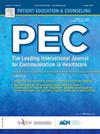Does cancer literacy predict cancer screening intention or uptake? A systematic review
IF 3.1
2区 医学
Q2 PUBLIC, ENVIRONMENTAL & OCCUPATIONAL HEALTH
引用次数: 0
Abstract
Objective
To examine the association between cancer literacy (CL) and cancer screening behaviors, including screening intention and uptake.
Methods
A comprehensive search was conducted across three databases up to October 2024 (CRD42024500935). Studies were included if they (i) had an observational design, (ii) measured CL using validated or ad hoc tools, and (iii) quantified its association with cancer screening intention and/or uptake. Quality was assessed using the Newcastle-Ottawa Scale. Findings were narratively synthesized by cancer type for each outcome.
Results
Six cross-sectional studies met the inclusion criteria: one focused on screening intention, four on screening uptake, and one on both outcomes. Data were available for breast, cervical, colorectal, prostate, and skin cancer. Study quality was heterogeneous, with most studies rated as fair quality and affected by methodological limitations, including reliance on self-reported data, imprecise outcome definitions and measurements, and heterogeneous target populations. While higher levels of CL were linked to increased screening intentions in both included studies, findings on screening uptake were inconsistent across and within cancer types, with significant associations more commonly observed in adjusted analyses. Although a few studies suggested that awareness of the importance of preventive measures may influence screening adherence, the overall results remained inconclusive across all cancer types.
Conclusions
This review suggests a positive association between higher CL and cancer screening intentions, although the evidence is limited. The role of CL in screening uptake remains uncertain, indicating that additional factors may influence adherence. Given the limited evidence, methodological variability, and study limitations, further research employing more robust and standardized approaches is essential to better understand the role of CL in cancer-related behaviors.
Practical Implications
Improving CL may have a role in shaping cancer screening behaviors, particularly in promoting screening intention. More rigorous research is needed to clarify the role of CL in screening behaviors.
癌症知识是否能预测癌症筛查的意向或接受程度?系统回顾
目的探讨癌症素养(cancer literacy, CL)与癌症筛查行为(包括筛查意愿和接受程度)之间的关系。方法对截至2024年10月(CRD42024500935)的3个数据库进行综合检索。如果研究(i)具有观察性设计,(ii)使用经过验证的或专门的工具测量CL,以及(iii)量化其与癌症筛查意图和/或摄取的关联,则纳入研究。使用纽卡斯尔-渥太华量表评估质量。每个结果的结果按癌症类型进行叙述性综合。结果6项横断面研究符合纳入标准:1项关注筛查意向,4项关注筛查吸收,1项关注两项结果。有乳腺癌、宫颈癌、结直肠癌、前列腺癌和皮肤癌的数据。研究质量参差不齐,大多数研究被评为质量一般,但受到方法学局限性的影响,包括依赖于自我报告的数据、不精确的结果定义和测量,以及不同的目标人群。虽然在两项纳入的研究中,较高的CL水平与筛查意愿的增加有关,但在不同癌症类型之间和癌症类型内部,筛查摄取的结果不一致,在调整分析中更常见地观察到显著的关联。尽管一些研究表明,对预防措施重要性的认识可能会影响筛查的依从性,但对所有癌症类型的总体结果仍不确定。结论:尽管证据有限,但本综述提示高CL与癌症筛查意图之间存在正相关。CL在筛查摄取中的作用仍不确定,表明其他因素可能影响依从性。鉴于有限的证据、方法的可变性和研究的局限性,采用更可靠和标准化的方法进行进一步的研究对于更好地了解CL在癌症相关行为中的作用至关重要。实际意义改善CL可能在塑造癌症筛查行为,特别是促进筛查意愿方面发挥作用。需要更严格的研究来阐明CL在筛查行为中的作用。
本文章由计算机程序翻译,如有差异,请以英文原文为准。
求助全文
约1分钟内获得全文
求助全文
来源期刊

Patient Education and Counseling
医学-公共卫生、环境卫生与职业卫生
CiteScore
5.60
自引率
11.40%
发文量
384
审稿时长
46 days
期刊介绍:
Patient Education and Counseling is an interdisciplinary, international journal for patient education and health promotion researchers, managers and clinicians. The journal seeks to explore and elucidate the educational, counseling and communication models in health care. Its aim is to provide a forum for fundamental as well as applied research, and to promote the study of organizational issues involved with the delivery of patient education, counseling, health promotion services and training models in improving communication between providers and patients.
 求助内容:
求助内容: 应助结果提醒方式:
应助结果提醒方式:


